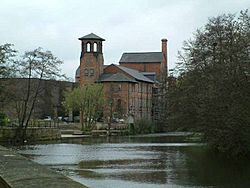Derby Silk Mill facts for kids

The museum and the River Derwent
|
|
| Lua error in Module:Location_map at line 420: attempt to index field 'wikibase' (a nil value). | |
| Established | 1974 |
|---|---|
| Location | Derby, England |
| Type | Industrial museum |
Derby Silk Mill, also known as the Museum of Making, is a cool museum in Derby, England. It teaches us about industry and history. This museum is built on the spot of an old and very important silk mill called Lombe's Mill. This historic site marks the start of the amazing Derwent Valley Mills World Heritage Site.
The museum first opened its doors as Derby's Industrial Museum on November 29, 1974. Later, a huge project to make it even better began in 2016. The museum then reopened with its new name, the Museum of Making, on May 21, 2021.
The Museum's Story
The building where the museum stands has a long history. It was first used as Derby’s Industrial Museum, which opened in 1974.
In April 2015, the museum temporarily closed its doors. This was part of a plan by Derby City Council to help fund big improvements. The goal was to make the Silk Mill and other museums in the city even better for visitors.
Discover the Museum of Making
In October 2016, a huge £17 million project began. The aim was to completely redesign the museum for the 21st century. This new design focused on STEAM principles. STEAM stands for Science, Technology, Engineering, Art, and Mathematics.
The museum officially reopened as the Museum of Making on May 21, 2021. It quickly started winning awards! In its first year, it received a 'Highly Commended' award. This was for being a 'Sustainable Project of the Year'.
In September 2021, it won the National Construction News Award. It was named 'Project of the Year Under £25m'. It also won five more awards that year. These were at the Constructing Excellence East Midlands Awards. In May 2022, the Museum of Making was even chosen as a finalist. It was considered for the prestigious 2022 Art Fund Museum of the Year award.
Most of the museum's exhibits are on the upper floors. This helps protect them from damage. For example, in October 2023, there was a flood from Storm Babet. The museum had to close because of this. It reopened to visitors on January 25, 2024.
More to Explore
- Listed buildings in Derby (Arboretum Ward)
See also
 In Spanish: Derby Industrial Museum para niños
In Spanish: Derby Industrial Museum para niños

